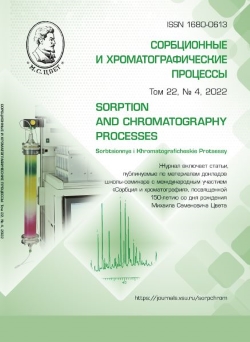Chromatographic extraction of succinate dehydrogenase isoenzymes from maize leaves under salinity stress
Abstract
The purpose of our study was to obtain homogeneous succinate dehydrogenase (HSD) preparations from maize leaves and to study their characteristics determining their adaptive response to salinity stress. HSD has high genetic polymorphism, which may indicate the importance of its isoenzymes for the regulation of metabolism of plants and allows cells to form sets of molecular forms with different kinetic and regulatory characteristics. When using a multi-stage purification scheme of molecular forms of the said enzyme system, we obtained its preparations in a homogeneous state. The key stage was ion exchange chromatography on DEAE Sephacel. It allowed us to separate the isoenzymes of the studied enzyme from maize leaves under salinity stress. The study demonstrated that all isoenzymes are desorbed from DEAE Sephacel at various concentrations of potassium chloride, which may indicate the presence of a structural organisation of polypeptide components of the isoforms of succinate dehydrogenase. The specific activity of the obtained preparations was 0.935 U/mg of protein and 1.495 U/mg of protein for isoenzymes HSD1 and SHD2 respectively. The yield was 42.31% and 35.05%. Electrophoretic analysis of the HSD isoenzymes obtained using DEAE-cellulose demonstrated that universal development for proteins revealed a single protein band in each of the studied samples. Therefore, the obtained preparations of succinate dehydrogenase are electrophoretically homogeneous. The study determined that isoenzymes of succinate dehydrogenase from maize leaves had different degrees of sorption on DEAE Sephacel ion exchanger, which is confirmed by the elution of the components from the column. Desorption of the HSD1 and HSD2 isoenzymes from the DEAE Sephacel column occurred when the concentrations of KCl were 91.65 mM and 174.95 mM respectively, which means that isoenzymes of succinate dehydrogenase from maize leaves have different charges. Changes in the pH of the mitochondrial matrix effect the conformational states of the protein components of HSD isoenzymes, as well as the surface charge of the molecule and the ionization of amino acid residues of the active centre of the enzyme, which in turn affects the affinity to the substrate.
Downloads
References
Eprintsev A.T., Popov V.N., Fedorin D.N. Sukcinatdegidrogenaza vysshih rastenij. Voronezh: Center. Chern. Book publishing house. 2010. 184 p. (In Russ.)
Millar A.H., Eubel H., Jansch L., Kruft V., Heazlewood J.L., Braun H-P. Structure of Mitochondrial Respiratory Membrane Protein Complex II. Plant Molecular Biology. 2004; 56; 77-90. https://doi.org/10.1007/s11103-004-2316-2
Sun F., Huo X., Zhai Y., Wang A., Xu J., Su D., Bartlam M., Rao Z. Structure of Mi-tochondrial Respiratory Membrane Protein Complex II. Cell. 2005; 121(7); 1043-1057. https://doi.org/10.1016/j.cell.2005.05.025
Cammack R., Maguire J.J., Ackrell B.A.C. Mechanisms of Electron Transfer in Succinate Dehydrogenase and Fumarate Reductase: Possible Functions for Iron-Sulphur Centre 2 and Cytochrome b. Cytochrome Sys-tems. 1987; 485-491. https://doi.org/10.1007/978-1-4613-1941-2_68
Balnokin Yu.V., Kotov A.A., My-asoedov N.A., Khailova G.F., Kurkova E.B., Lunkov R.V., Kotova L.M. Uchastie dal'nego transporta Na+ v podderzhanii gradienta vodnogo potenciala v sisteme sreda – koren' – list u galofita Suaeda altissima. Fiziologiya ras-teniy. 2005; 52: 549‒557. https://doi.org/10.1007/s11183-005-0072-z (In Russ.)
Jacoby R.P., Che-Othman M.H., Millar A.H., Taylor N.L. Analysis of the sodium chloride-dependent respiratory kinetics of wheat mitochondria reveals differential effects on phosphorylating and non-phosphorylating elec-tron transport pathways. Plant, Cell & Envi-ronment. 2016; 39: 823-833. https://doi.org/10.1111/pce.12653
Prasada R.K., Lall A.M., Abraham G., Ram G., Ramteke P.W. Prasada R.K., Lall A.M., Abraham G., Ram G., Ramteke P.W. International Journal of Bioinformatics and Biological Science. 2013; 1(3): 293-302.zInternational Journal of Bioinformatics and Biological Science. 2013; 1(3): 293-302.
Popov V.N., Eprintsev A.T., Fedorin D.N. Svetovaya regulyaciya ekspressii suk-cinatdegidrogenazy v list'yah arabidopsis thali-ana. Fiziologiya rasteniy. 2007; 54: 409-415. (In Russ.)
Lowry O.H., Rosebrough N.J., Farr A.L., Randall R.J. Protein measurement with the Fo-lin phenol reagent. Journal Biological Chemis-try. 1951; 193: 265-275. https://doi.org/10.1016/s0021-9258%2819%2952451-6
Schilling B., Murray J., Yoo C.B., Row R.H., Cusack M.P., Capaldi R.A., Gibson B.W. Proteomic analysis of succinate dehydro-genase and ubiquinol-cytochrome c reductase (Complex II and III) isolated by immunoprecip-itation from bovine and mouse heart mitochon-dria. Biochimica et Biophysica Acta (BBA). 2006; 1762: 213-222.
Fedorin D.N., Karabutova L.A., Pokusina T.A., Eprintsev A.T. Vydelenie izoform sukcinatdegidrogenazy iz zelenyh list'ev kukuruzy metodom ionoobmennoj hromatografii. Sorbtsionnye i khromatograficheskie protsessy. 2016; 16(4): 544-549. (In Russ.)
Fedorin D.N., Eprintsev A.T. Vydelenie izofermentov sukcinatdegidrogenazy iz list'ev goroha metodom ionoobmennoj hromatografii. Sorbtsionnye i khromatograficheskie protsessy. 2018; 18(4): 563-567. https://doi.org/10.17308/sorpchrom.2018.18/564 (In Russ.)
Kader M.A., Lindberg S. Cytosolic calcium and pH signaling in plants under salinity stress. Plant Signal Behavior. 2010; 5(3): 233-238. https://doi.org/10.4161/psb.5.3.10740
Selemenev V.F., Rudakova L.V., Rudakov O.B., Belanova N.A., Nazarova A.A., Fosfolipidy na fone prirodnyh matric Voronezh. Nauchnaya kniga. 2020. 318 p. (In Russ.)
Selemenev V.F., Rudakov O.B., Slavinskaya G.V., Drozdova N.V. Pigmenty pishchevyh proizvodstv (melanoidiny). M. Delhi print. 2008. 246 p. (In Russ.)







